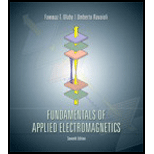
Concept explainers
A plane wave in air with an electric field amplitude of 20 V/m is incident normally upon the surface of a lossless, nonmagnetic medium with ϵr = 25. Determine the following:
- (a) The reflection and transmission coefficients.
- (b) The standing-wave ratio in the air medium.
- (c) The average power densities of the incident, reflected, and transmitted waves.
(a)
The reflection coefficient
Answer to Problem 1P
The reflection coefficient
Explanation of Solution
Given data:
The electric field amplitude
The permittivity
Calculation:
The reflection coefficient
Here,
Write formula to find intrinsic impedance.
Here,
So, find intrinsic impedance of the medium
Hence,
Here,
Substitute
Now, find intrinsic impedance of medium 2.
Here,
Substitute
Substitute
The transmission coefficient
Here,
Substitute
Conclusion:
Therefore, the reflection coefficient
(b)
The standing-wave ratio
Answer to Problem 1P
The value of standing-wave ratio
Explanation of Solution
The calculated value of reflection coefficient
Calculation:
The standing-wave ratio is given by,
Here,
Substitute
Conclusion:
Therefore, the value of standing-wave ratio
(c)
The average power density of the incident
Answer to Problem 1P
The value of average power density of the incident wave
Explanation of Solution
Given data:
The electric field amplitude
The calculated value of intrinsic impedance of air
The calculated value of reflection coefficient
Calculation:
The average power density of the incident
Here,
Substitute
The average power density of the reflected
Substitute
The average power density of the transmitted
Substitute
Conclusion:
Therefore, the value of average power density of the incident wave
Want to see more full solutions like this?
Chapter 8 Solutions
Fundamentals of Applied Electromagnetics (7th Edition)
- A plane electromagnetic wave is having a frequency of 20 MHz. If the value of relative permitivity and relative permeability is 5 and 4 respectively, what will be value of the velocity of the wave provided the medium is lossless.arrow_forwardIf for a plane wave, the electric field strength is 2 V/m and the magnetic field strngth is 5.2 mA/m, then estimate the value of the intrinsic impedance of the propagating mediumarrow_forwardHow would you classify (imperfect dielectric or good conductor) the two materials, a and b, in which uniform plane waves of the same requency are propagating given with the following electric fields, respectively:arrow_forward
- If the phase velocity of the wave propagating in a rectangular waveguide filled with a material with a relative dielectric constant of 9 is 3.2*10^8 m/s, what is the propagation speed of electromagnetic energy in Mm/s (megameters/second)?arrow_forwarda) Compare E and H in dielectric and well-conducting medium with E and H in empty space.b) How can you absorb electromagnetic waves in the microwave region? Please explain.c) A spacecraft returning to Earth has 1015 m-3 ionized atoms around it and creates a density. Find the plasma frequency accordingly. Determine the cutoff wavelength taking into account communication with the ground station.arrow_forwardWhat are reflection and transmission coefficients? Derive the formula for the same. When an EM wave travels from a dielectric (medium-1) to the conductor,then what will be the value of these parameters?arrow_forward
- The E field of a plane electromagnetic wave traveling in a non- magnetic non- conducting medium is given by E=ax5cos(109t+30Z). What is the dielectric constant of the medium ?arrow_forwardWhich is correct for the reflection and transmission coefficients of the electromagnetic wave perpendicular to the plane surface separating the two dielectric mediums. The impedance of the medium with the incoming wave is 100 ohms, and the impedance of the medium with the transmitted wave is 200 ohms. a-Reflection coefficient 3, transmission coefficient 4b-Reflection coefficient 1/3, transmission coefficient 4/3c-Reflection coefficient -1, transmission coefficient 0d-Reflection coefficient 1, transmission coefficient 2arrow_forwardType your question here A 150-MHz uniform plane wave is normally incident from air onto a material whose intrinsic impedance is unknown. Measurements yield a standing wave ratio of 3 and the appearance of an electric field minimum at 0.3 wavelengths in front of the interface. Determine the impedance of the unknown material.arrow_forward
- If the speed of the electromagnetic energy of the wave propagating in a rectangular waveguide filled with a material with a relative dielectric constant of 9 is 3.125*10^7 m/s, what is the phase velocity of the electromagnetic wave in Mm/s (megameters/second)?arrow_forwardA wave is normally incident upon a surface with a layered lossless dielectric. Find the magnitude of effective reflection coefficient if medium 1 is free space, medium 2 has a relative permittiviy of 4 medium 3 has a permittivity of 9, and the thickness of medium 2 is 12/2. ...arrow_forwardConsider an instrument that transmits radio waves at different frequencies vertically into the ionosphere and measures the time it takes them to return. Using this technique, one can indirectly measure the electron density as a function of height. Assume a ground-based transmitter emits a vertical signal that sweeps over a range of 1 to 15 MHz. If the peak electron density in the ionosphere is 2×106 electrons/cm3, what range of frequencies will be reflected back to the instrument on the ground? Neglect any absorption effects. Frequencies from _____ MHz to ____ MHz will be reflected back. Report answers to 3 significant digits.arrow_forward
 Introductory Circuit Analysis (13th Edition)Electrical EngineeringISBN:9780133923605Author:Robert L. BoylestadPublisher:PEARSON
Introductory Circuit Analysis (13th Edition)Electrical EngineeringISBN:9780133923605Author:Robert L. BoylestadPublisher:PEARSON Delmar's Standard Textbook Of ElectricityElectrical EngineeringISBN:9781337900348Author:Stephen L. HermanPublisher:Cengage Learning
Delmar's Standard Textbook Of ElectricityElectrical EngineeringISBN:9781337900348Author:Stephen L. HermanPublisher:Cengage Learning Programmable Logic ControllersElectrical EngineeringISBN:9780073373843Author:Frank D. PetruzellaPublisher:McGraw-Hill Education
Programmable Logic ControllersElectrical EngineeringISBN:9780073373843Author:Frank D. PetruzellaPublisher:McGraw-Hill Education Fundamentals of Electric CircuitsElectrical EngineeringISBN:9780078028229Author:Charles K Alexander, Matthew SadikuPublisher:McGraw-Hill Education
Fundamentals of Electric CircuitsElectrical EngineeringISBN:9780078028229Author:Charles K Alexander, Matthew SadikuPublisher:McGraw-Hill Education Electric Circuits. (11th Edition)Electrical EngineeringISBN:9780134746968Author:James W. Nilsson, Susan RiedelPublisher:PEARSON
Electric Circuits. (11th Edition)Electrical EngineeringISBN:9780134746968Author:James W. Nilsson, Susan RiedelPublisher:PEARSON Engineering ElectromagneticsElectrical EngineeringISBN:9780078028151Author:Hayt, William H. (william Hart), Jr, BUCK, John A.Publisher:Mcgraw-hill Education,
Engineering ElectromagneticsElectrical EngineeringISBN:9780078028151Author:Hayt, William H. (william Hart), Jr, BUCK, John A.Publisher:Mcgraw-hill Education,





